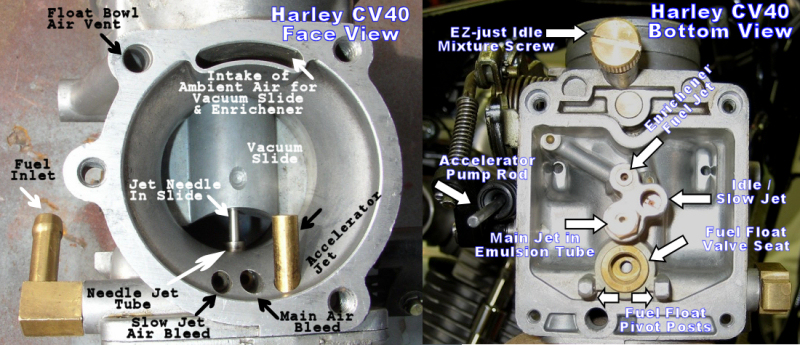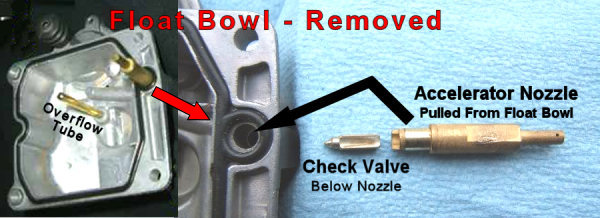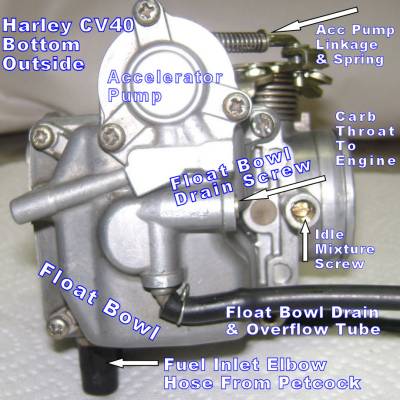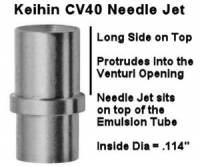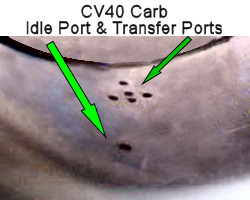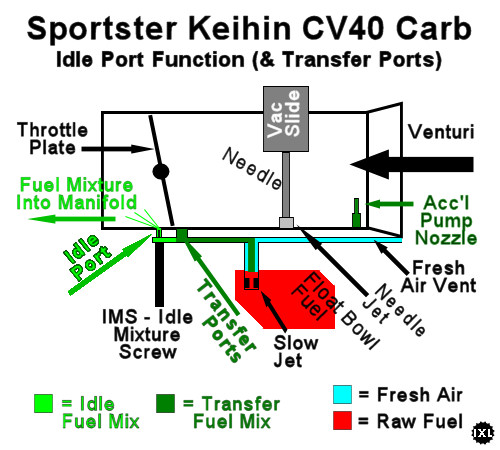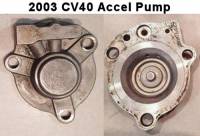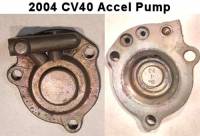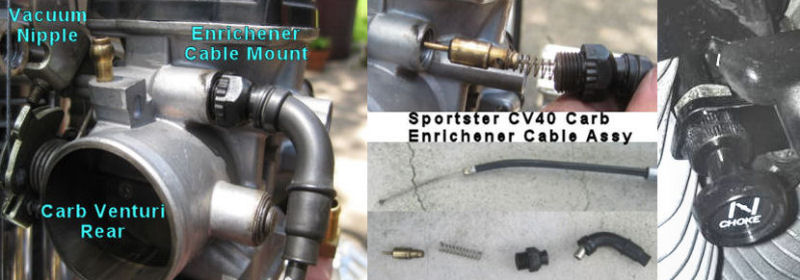Table of Contents
This is an old revision of the document!
EVO: Carburetor, Intake Manifold & Exhaust
CV CARBURETOR DESIGN
Design Info
From 1989-later, the carburetor installed on Sportsters was made by Keihin. It has a 40mm maximum venturi, but the design of the constant-velocity carb utilizes a vacuum-operated slide to vary the venturi opening to help maintain a good air velocity throughout the carbs operating range.
The CV40 uses a gravity-fed fuel supply through a float controlled inlet valve to fill a fuel supply bowl, from which the internal jets obtain fuel. It also has an enrichment system (mislabeled choke) that provides a pathway for fuel to bypass the carb and be supplied directly into the manifold for better starting.
There are a number of parts that operate in combination to control the mixing of fuel & air into a combustible fuel mixture. The vacuum slide, needle, main jet, slow jet, idle mixture screw, idle ports, tranfer ports and accelerator pump, all assist in this mixing operation over the range of operating conditions.
The constant-velocity system provides a partial means of compensating for operation at different altitudes. In a fixed system, as altitude increases, the fuel mixture becomes richer due to the thinner air. But the CV system partially compensates for this fact because the vacuum-slide oparation is also affected by the thiner air, thereby supplying less fuel into the mix.
The CV40 (1989-later) has an accelerator pump, controlled by a rod attached to the throttle cable cam, to provide additional fuel when the throttle is quickly opened for acceleration. It squirts raw fuel into the venturi throat to enhance the fuel mixture along with the quickly added air.
The carb has been adjusted to control exhaust emissions. The idle mixture is set at the factory and the adjusting screw is capped because it is not to be adjusted except by factory technicians.
Note from the service manual: Adjusting mixture setting by procedures other than specified in this section may be in violation of local regulations.
Some Tuning Considerations
To obtain a perfect tune, for a specific bike, would require a number of dyno runs with mini-changes done to the timing & carb AFR between runs. Even then, perfection is most often fleetingly confined to a narrow portion of the throttle curve, while the remainder is 'good enough', but not perfect.
With most DIY riders, who wish to tune their own bikes, they don't have access to cheap dyno time and they don't have a collection of needles & jets to perfectly tweak the tune. Instead, they are mostly confined to having one or two needles and a few (maybe 3 or 4) jets to make AFR changes. Timing could be adjusted where there is a cam sensor plate, but after 2004, the timing was held captive inside the ignition module. This required a computer to access and change it or the rider must rely on the local dealer to 'reflash' the latest upgrade and hope the MoCo got it right.
Even so, if done methodically, with careful attention to detail, most DIY riders do get their tune 'close enough' to match the modified air cleaner & exhaust upgrade (generally known as a Stage One upgrade) with just a handful of parts.
Over the years there have been many different approaches to tuning the CV carb - some of them simply distorting the tune to skew it's operation toward some (perceived) 'enhancement' of a specific part of the throttle operation curve. Unfortunately, when most of this advice is followed, the normal street rider is left with 'problem' areas in the overall throttle curve and they then use 'trial & error' with many other changes to address those 'tune created' problems. It doesn't take long to be confused and dissatisfied.
With the collected results of many years of (reported) experimentation, some of the older suggestions have been found to be unacceptable for a good overall carb tune. Therefore, just because it was recommended in the past does not make it a good idea. This is especially true where permanent modifications (damage) are suggested for the stock carb parts. In the XLForum, there is quite a general consensus (although some still disagree) that a well tuned carb for the entire throttle curve, is one with NO permamently modified carb parts, but rather, that tune only uses a change in the needle and jets while carefully tuning the carb adjustments.
Another issue created by the factory carb settings to meet EPA regs, is that the CV carb has often had off-idle carb farts with the factory tune, which flare up with stage 1 modifications. There have been a number of proposed 'solutions' to the carb fart problem (with some of those 'solutions' creating other issues).
Below you will find many collected suggestions that should get a Stage One, 1200cc Sportster properly tuned for a balance of performance and smooth, reliable, street operation. The same principles will apply to 883 models and also to somewhat-upgraded (1250/1275) engine sizes, but with the necessary parts altered to meet the needs of the particular engine.
WORKING WITH CV40 CARBURETORS
Diagnosing CV Carb Issues
Eliminate Intake Air Leaks Mounting the CV Carb properly is critical. Check when mounting (or remounting or having issues with) the carburetor that the alignment between the carb and the manifold is correct. The reason this is so important is because misaligned mounting will cause tuning problems because any leaks will alter the Air-to-Fuel Ratio.
Before inserting the carb into the manifold rubber seal, apply a very light coating of oil around the inside of the rubber seal - This helps prevent the rubber from distorting during the insertion.
Use a bracket to actually mount the carb to the cylinder-heads - Don't just hang it on the manifold.
If you are using breather bolts (1991-2006), insert them through the banjo fittings - with sealing washers on either side of the banjo fittings - Then through the mounting bracket and into the cylinder-head mounting (breather) holes - add washers behind the bracket to take up any additional space that remains between the support bracket and the cylinder-heads…
See the section titled "Mounting the CV Carb - Preventing Air Leaks"
This process will give you a good rigid mount of the carb to the cylinder-heads while maintaining a good alignment of the carb with the manifold, all working together to eliminate those pesky intake air leaks.
1)
Check the Slide Diaphragm - Be sure the slide operates correctly & the diaphragm is not torn or punctured. To do this, remove the air cleaner and reach your finger into the carb throat to the slide - push the slide up and quickly let the slide fall down. You should hear the vacuum sound as the slide returns to the bottom position.
This is from an XLForum thread: chrishajer wrote - CBAS5 and I were talking about what it should sound like, good, and we filmed that one. Then he said “you know, we should show a bad one too” so we did that. I think the [vacuum] sound and the speed that the slide comes down are the two most important things. Those things you can't describe to someone really. I can't anyway. But it's absolutely the best way to verify that the diaphragm is seated properly.
YouTube Video of GOOD working slide ………
YouTube Video of MALFUNCTIONING slide
Aftermarket Parts are promoted as upgrades to peak the carb performance. Sometimes they do create better performance for one part of the carb operation. But most often, they simply distort the proper overall performance and create ongoing issues that are difficult or impossible to resolve. If you're racing, the setup for normal street operation may be irrelevant, but for most riders, getting good performance in all conditions is important. Keep this in mind when evaluating any promises of upgrade products.
Mixing Parts from various carb kits (such as needles, emulsion tubes, springs, etc.) can lead to major issues when trying to get the tuning right. A mix of parts may lead to one particular operation working correctly while nearly always disturbing the proper functioning of the carb across the entire operational range, from idle to WOT. Do not mix parts. The OEM/Keihin parts allow a proper tune with only minor changes to the jetting or needle choices.
Slow jets from fixed venturi carbs look the same as the ones used in CV carbs. However, the air bleed hole sizes are different on fixed venturi carbs and must not be used in CV carbs. 2)
Before Tuning - Collect Your Information
To prepare for tuning, start by checking what parts are in your carburetor. The factory jets and slide tube may have been altered to aftermarket parts. Some aftermarket parts are not compatible with factory parts. When buying rebuild kits, there may be extra parts not needed for your particular carb model.
When tuning, it is often less expensive to just buy the parts you actually need rather than tuning kits, which can get pricey. So planning ahead is a good idea. Know what you have before buying additional parts.
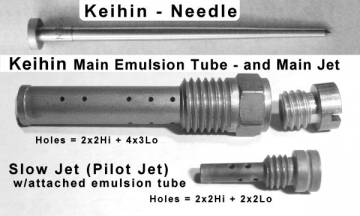 The “DynoJet” kits (and many equivalent ones) can be an issue. Typically, they replace the factory needle, emulsion tube, main jet & diaphragm/slide spring. They also recommend that you drill the slide vacuum hole out for quicker throttle response. The DynoJet emulsion tube and main jets are not compatible with the Keihin emulsion tube/jets - they use different threads. There are even FAKE Dynojet kits that have shown up on the market, presumably from China 3)
The “DynoJet” kits (and many equivalent ones) can be an issue. Typically, they replace the factory needle, emulsion tube, main jet & diaphragm/slide spring. They also recommend that you drill the slide vacuum hole out for quicker throttle response. The DynoJet emulsion tube and main jets are not compatible with the Keihin emulsion tube/jets - they use different threads. There are even FAKE Dynojet kits that have shown up on the market, presumably from China 3)
To check for DynoJet parts, look at these 4 things: 4)
- Check the Needle: Stock is Nail-shaped - DJ has grooves & a clip
- Check the Diaphragm/Slide Spring: Stock is 6.0“ - DJ is 5.75”
- Check the Slide Vacuum Port Hole (not the center hole): Stock is .097“ - DJ is .136” (Is the hole smaller or larger than 7/64“ drill bit?)
- Check the Main Emulsion Tube : Stock has 2x2Hi+4x3Lo Emulsion Holes - DJ uses only 2Lo Holes
- The stock Keihin Emulsion Tube uses 6mm Main Jets - The DJ one takes only 5mm jets, which are incompatible with the Keihin tube and only available from DJ
Here's the Dynojet Fraud Alert Press Release regarding counterfeit jet kits:
dynojet-pressrelease-knockoffjetkits.pdf
While some people have had satisfactory results with the DJ kits, if you are having trouble getting a good tune on the carb, I would remove all DJ items and restore the carb to Keihin parts including buying another slide if it's been drilled. The stock parts are good quality and will provide excellent operation if the carb is tuned properly.
From the factory, there is a cap over the Idle Mixture Screw. This needs to be removed to make IMS adjustments during tuning. It does not need to be replaced when done, but the cap is available as HD P/N 28015-01 if you would like to replace it when done making changes.5)
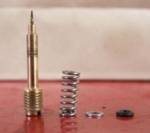 The Idle Mixture Screw “packing” (spring, washer, o-ring) and the screw itself was never meant to be removed or tampered with, according to the MoCo, due to EPA regulations. This was adjusted and the screw covered with a soft aluminum cap at the factory before initial installation on your bike. None of these packing items are offered as replacement parts from your HD dealer, so you will need to look to the aftermarket suppliers for parts.
The Idle Mixture Screw “packing” (spring, washer, o-ring) and the screw itself was never meant to be removed or tampered with, according to the MoCo, due to EPA regulations. This was adjusted and the screw covered with a soft aluminum cap at the factory before initial installation on your bike. None of these packing items are offered as replacement parts from your HD dealer, so you will need to look to the aftermarket suppliers for parts.
To remove the IMS cap, carefully drill a small hole in the center of the cap (barely enough to make a hole). Be extremely careful not to overdrill into the cap because you will damage the screw that is behind the cap. Now, carefully twist in a sheetmetal screw about one thread, then pull on the screw to remove the cap.
An aftermarket kit (like E-Z-just) can be purchased with an extended screw head for hand tuning. It comes with the “packing” in case yours has been damaged or is not functioning properly. But, check your local regulations before changing this out to an aftermarket part. You can also find, buy or barter for used parts. (“Please note: it is a violation of federal law to tamper with or disable any emission or noise control device. That is your PSA for the day”6)).
Checklist Of What You Have - In order for others to provide quality advice, it is important that you know and can provide quality information about the build of your bike. Here's a list of important information for you to know and provide for TUNING of the CV carburetored EVOs (1986-2006):
| Engine Size | (Stk883, Stk1200, Stk1100, Stk900, Stk1000, Conv883-1200, Conv883-1250, etc.) |
| Heads Installed | (Stock 883, Stock 1200, Specify Brand/Model) |
| Cam Installed | (Stock D, Stock W, Specify Brand/Model) |
| Compression Test | ( Min120PSI for 883 - Min150PSI for 1200 ) |
| Ignition Module | (Stock 883, Stock 1200, Specify Brand/Model#) |
| VOES being used | (Y/N) |
| VOES Vacuum Mod'd | (Checked/Changed the Switch Point?) |
| Air Cleaner | (Stock, Specify Brand/Model) |
| Breather Venting | (Head Into Carb, Head Out to Air, Crankcase) |
| Exhaust | (Stock, Specify Brand/Model/Baffles/TqCones) |
| Spark Plugs Used | (Stock, Specify Brand/Model#) |
| What Model Carb | (Stock CV, Specify Brand/Model) |
| Check for Intake Leak | (Y/N) (Use UNLIT propane torch near manifold ports) |
| Petcock | (Stock Vac, Modified, Specify Brand/Model#) |
| Vacuum Line Checked | (Y/N) |
| Enrichener Cable Seated | (Y/N) |
Inside of CV Carburetor:
| Slow Jet | (Stock, Specify Known Size) |
| Idle Mixture Screw | (Set at xxx turns from lite seat) |
| IMS set by Idle Drop | (Y/N - Did you change it?) |
| Drilled Slide? | (Y/N - Based on who's recommendation?) |
| Altered Slide Spring? | (Y/N - Based on who's recommendation?) |
| Jet Needle | (Stock, DJ, Other Keihin, Specify Brand/#) |
| Emulsion Tube | (Stock, DJ, Specify Known Brand/#) |
| Main Jet | (Stock, DJ, Specify Known Brand/Size#) |
| Fuel Float Level Set | (Y/N - Stock, Other) |
| Fuel Float Valve | (Y/N - Cleaned & Checked, Replaced) |
TIPS
If you don't know your engine size, check it with a straw - Like this: * Put in 5th gear * Lift rear wheel * Remove spark plugs * Place a long plastic straw in the spark plug hole * Rotate tire to move cylinder to bottom dead center - lowest straw position * Check cylinder diagonal dimension from far bottom of cylinder to lip of spark plug hole * 883 bore = 5.5" Diagonally ---- (Actual Bore Dia. is 3.000) * 1200 bore = 5.875" Diagonally - (Actual Bore Dia. is 3.498) The plastic straw is unable to damage the cylinder and unlikely to fall into the cavity...
Before Tuning - Setup Everything Else
Following an organized and thorough PreOp and Parked checklist will help you understand what you observe when you actually begin the operational testing of the carb during rides…
Here's my suggested list (for 1200 models, although 883s should be mostly the same except maybe the initial jetting) - Even if you've done some of these, being orderly and thorough, doing everything on the checklist will have benefits, especially if you've made changes since your last efforts at tuning…
Check Items Ahead of the Carb
- Check your vacuum lines for good connection & no cracks
- Check your VOES - that it switches with vacuum - later check switching point
- Check your gas tank for debris - remove & clean if needed
- Check your petcock for leaks (bad diaphragm) - Make sure vacuum petcocks open on vacuum
- Check gas line & connectors for wear/breaks/pinches
- Check your petcock for flow rate - Pull the hose from the carb, open petcock (draw vacuum if needed)
- How long does it take to flow one quart (32oz) of fuel?
Internal Carb Checks
- Carefully disassemble carb and all parts - Clean the carb body & each part
- Spray *ALL* ports, passages & jets - Get everything clean to start
- Check your float bowl - clean passages - remove any debris - set/check float level (see below)
- Use only the 4-sided type Float Bowl Valve (not the 3-sided type)
- I prefer eliminating any non-Keihin parts (ie., dynojet kits, etc.)
- (DynoJet Kits may have changed jets, needle, spring, drilled diaphragm, etc.)
- Check/Clean Emulsion Tube (which holds Needle Jet in place and mounts Main Jet)
- Pull Needle Jet - Make sure it's clean & properly installed (Long Side Up)
- Start with 175 or 180 Main Jet in Emulsion Tube (not critical until WOT settings)
- Start with 42 or 45 Idle Jet - Do not start with 46 or more - change later if needed
- Use a standard Keihin needle in slide (no washers to start) (1200 likes N65C Needle)
- Use stock spring & needle cage (spider)
- Check Diaphragm condition - no tears - seat it carefully (properly) on install
- Check Slide moves smoothly up & down with no burrs or catches
- Check Accelerator pump - Point spray hole directly at main needle
- Be sure to reinstall pump rod correctly
- Be sure you have removed each part, cleaned the ports & reinstalled correctly
- Set the Idle Set Screw (located on the right side of the carb, near the throttle cables)
so that the Throttle Plate is between the Idle Port (one hole in the carb throat) and the
Transfer Ports (which consists of 5 holes nearby)
Click on the small image below for the detailed instructions regarding setting the float level:

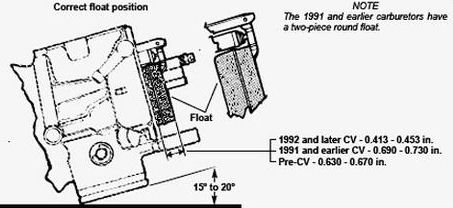
External Carb Checks & Adjustments
- Check intake seals on manifold (at heads) - replace now while it's apart
- Check intake seal between manifold & carb - replace now
- Minimize Throttle Plate opening at idle - Set it between Idle Port & Transfer Ports (See this XLForum thread)
- Check Idle Mixture Screw (IMS) screw/spring/washer/o-ring condition - clean port
- Check IMS seat (Has the screw needle tip deformed the hole?)
- Set initial IMS to 2-1/2 turns out from lite seat
Change the Screws
Replace the mounting screws used for the float bowl and for the diaphragm cover. They come with standard metal Phillips head screws. Replace these with Stainless Hex Socket Head (Allen Head) Screws. Using lock washers & flat washers in stainless is also a good idea.
Both sets of screws are 4mm Dia X .70 Thread Spacing. The socket head screws take a 3mm hex wrench.
You'll need (4) screws that are 16mm in length for the float bowl. Then you'll need (3) screws that are 16mm in length and (1) screw that is 20mm in length for the Diaphragm Cover. If you choose to use Button Head Socket Screws for the top cover, they use a 2.5mm hex wrench.
You can also replace the (3) Accelerator Pump screws with 4mm x 10mm long. 7)
Reinstall Carb & Air Cleaner
- Be sure to use light oil coating on intake manifold seal to help slide carb into place
- You MUST use (some type of) a bracket to actually mount the carb to the cylinder-heads
- Check that mounting the carb does not disturb its position in the manifold
- Reference the section titled ”Mounting the CV Carb - Preventing Air Leaks“
- BE SURE to check that your throttle cables fully open & close the Throttle Plate!
- If your heads use breather bolts - Use external head breather system to eliminate oil in air cleaner & cylinders
- Do not lubricate the enrichment cable (misnamed Choke) on CV Carburetors - tension is needed. 8)
IDLE & TRANSFER TUNING ADVICE
Overview
- ALL TUNING should be done after the engine has warmed up thoroughly - Try a 10-15 minute ride
- Check carburetor-to-manifold-to-heads for air intake leaks - Unlit propane torch will alter idle
- Set the IMS - See the “Idle Drop Method” mentioned in the “Detailed Tuning Advice” section below
- Adjust Idle Set Screw so bike idles well - 950-1050 RPMs
Check Accelerator Pump
- Check Accelerator pump - Twist throttle, see that it squirts directly at main needle
Check Transfer Operation
- Check Response to Blipping the Throttle (while parked) - should be crisp & responsive
The Idle/Transfer Ports Operation & Tuning
Every carb is a little different, so the tuning must be done while monitoring the engine response. All the parts need to work correctly so it's best to check & set some parts beforehand so nothing unnecessarily distorts the carb operation.
Because of the constant-velocity design, where the vacuum slide works as a partner with the throttle plate, the throttle being wacked open DOES NOT equate to the carb operating at wide open. The vacuum slide responds to the throttle plate opening and increases the carb venturi in response to the change in vacuum (more vacuum in the slide chamber, bigger venturi). In essence, the vacuum slide makes the CV carb operate as a variable-venturi carb, becuase the size of the throat opening is altered by the vacuum slide.
The Idle Port is intended to supply the necessary fuel mix when the engine is idling, but it also continues to help feed fuel mix during the transfer operation and minimal speed cruising. The Transfer Ports are intended to add more fuel mix when the throttle plate begins to open during the period between idling and the mid-range operation of the engine. If the throttle is opened quickly, the Accelerator Pump will supply a shot of fuel to mix with the increased air passing thru the venturi.
The Transfer Ports continue to actively supply fuel for the carb operation, although, as the throttle/slide/needle increase the engine speed, the Transfer Ports represent a smaller & smaller percentage of the overall fuel supplied & consumed. When cruising at a minimum speed (with the throttle barely open), the Transfer Ports are still active (along with the needle in the needle jet) in supplying fuel for the carb operation.
The mid-range operation is mostly handled by the needle position in the needle jet, followed by the main jet metering fuel when the throttle/slide/engine is operating at Wide Open Throttle, with the needle fully retracted from the needle jet.
Discussion Thread regarding the relationship between the Transfer Ports and the Slow Jet (AKA Pilot Jet): http://xlforum.net/forums/showthread.php?t=1635658 9)
It is important to have the correctly sized Main Jet & Needle for the overall operation of the carb and so you can properly test the transition between idle & mid-range throttle operation. You can get a good starting point for a Stage One 1200 engine using a 175 main jet along with an N65C needle (which are a little richer than most stock parts). Later, you will need to verify whether those particular selections fit exactly what you need. You can use tuning methods for mid-range and wide-open-throttle operation to evaluate your choices. But, those parts are not directly involved in tuning the idle & transfer functions.
Main Jet - The Main Jet itself does not begin to limit fuel delivery to the carb operation until the vacuum slide is 75-90% wide open and the engine is revving. Until then, other parts & factors (such as the idle mixture screw, slow-jet and needle position in the needle jet) are controlling the fuel utilized by the carb.
Needle - The needle does not begin to supply fuel until the throttle plate opens sufficiently to create a vacuum in the outer section of the venturi. The fuel mix supplied by your selected needle will combine with the transfer fuel mix of the slow jet as the carb operation moves out of the transfer period into the mid-range of the throttle/slide function.
Throttle Plate - To assure the throttle plate is capable of closing completely, back out the idle set screw (on the side of the carb near the throttle cable cam) so that it is not limiting the closing of the throttle plate. Carefully loosen the two throttle plate mounting screws, slightly. After the throttle plate is fully closed and has centered itself in the venturi, retighten the two mounting screws (don't overtighten & strip the threads). Make sure the throttle plate rotates smoothly with the throttle cable cam. Set the position of the throttle plate, with the idle set screw, so that the bottom edge of the plate is closed just past the transfer port holes and is thus located between the single idle port hole and the multiple holes of the transfer ports. If by chance, for any reason, you have the throttle plate completely off, be aware that there is a front and backside. Be sure the plate is remounted with the right orientation because each side has an angled edge to it.
 IMS Cap - From the factory, the cavity for the Idle Mixture Screw (IMS) is covered with a small cap. (Note from the service manual: Adjusting mixture setting by procedures other than those specified in the manual may be in violation of local regulations.) The following procedures are not specified in the manua. To remove the cap and gain access to the IMS, use a small drill bit to create a hole in the cap. Use several layers of tape on the drill bit to limit the depth the bit can penetrate the cap. If you pop thru the cap too deep with the bit, you may damage the IMS head. Be Careful. Once your cap has a hole in it, CAREFULLY thread a self-tapping screw (blunt nose) into the hole JUST ENOUGH to pull the cap out of the IMS cavity.
IMS Cap - From the factory, the cavity for the Idle Mixture Screw (IMS) is covered with a small cap. (Note from the service manual: Adjusting mixture setting by procedures other than those specified in the manual may be in violation of local regulations.) The following procedures are not specified in the manua. To remove the cap and gain access to the IMS, use a small drill bit to create a hole in the cap. Use several layers of tape on the drill bit to limit the depth the bit can penetrate the cap. If you pop thru the cap too deep with the bit, you may damage the IMS head. Be Careful. Once your cap has a hole in it, CAREFULLY thread a self-tapping screw (blunt nose) into the hole JUST ENOUGH to pull the cap out of the IMS cavity.
INTERACTIONS OF JETS & PORTS
The Slow Jet (AKA: Pilot Jet) & the Idle Mixture Screw (IMS), combined, determine the Idle Fuel Mix, while the Slow Jet alone determines the Transfer Fuel Mix. It is an important balancing chore to get all the parts involved in the Idle & Transfer functions to work well together to meet the needs of the engine operating range. As you change one part or setting, it may require making changes in other settings to keep or find the proper balance of the different fuel circuits. This concept also applies to the mid-range and wide-open-throttle operations.
The Transfer Ports rely on the properly sized Slow Jet for the Transfer Fuel Mix, especially since there is no other adjustment available to control that mix. This is an important consideration because the Transfer Fuel Mix is not only active during the brief period of transition between idle and acceleration, but is also active during the much longer period of minimal speed cruising, where the throttle plate is mostly-closed.
For this reason, it is important to guess-timate the proper Slow Jet before beginning your tuning. The most often supplied factory Slow Jet is a 42, although there are a number of models with a variation from that. If your model is an 883 with the stock air cleaner and exhaust system, you may stick with that jet to begin tuning. But if the air cleaner & exhaust have been upgraded (Stage One) or you have a 1200 engined model or beyond, it is generally recommended to increase the Slow Jet to a 45 before beginning your tuning. In some cases, the aftermarket 44 size may do well, but it has been found that the 48 size Slow Jet is almost never needed for proper tuning.
At idle, the Idle Port is supplying Idle Fuel Mix on the engine side of the throttle plate where the vacuum is high. The Transfer Ports are on the air cleaner side of the throttle plate where the vacuum is equal to the ambient air pressure and fuel is not being moved.
The Idle Mixture Screw (IMS) is used to meter the idle fuel mix into the Idle Port (that one little hole). Looking from the bottom of the carb upward, the IMS is turned counter-clockwise from GENTLY seated (fully closed) to increase the flow of Idle Fuel Mix into the Idle Port orifice.
The raw fuel for the fuel mix comes thru the Slow Jet and mixes with the fresh air from the Slow Jet Air Vent (located at the mouth of the carb). This fuel mix is being supplied past the Transfer Ports (inactive at idle) to the Idle Port, where the IMS will control the amount of fuel mix delivered into the carb venturi and thereby into the engine intake manifold.
Because the richness of the fuel mix is controlled by the Slow Jet, which incorporates an emulsion tube to mix fuel & air, the size of the Slow Jet has a direct effect on the proper setting of the IMS. When the Slow Jet is enlarged, the IMS gets a richer mix and can be set to a lower number of turns open to provide the same Idle Fuel Mix as with a smaller Slow Jet.
Having gained access to the IMS, it is recommended that you start by opening the IMS from GENTLY seated to 2-1/2 turns CCW. This setting is likely to be larger than the factory setting, which is often in the 1 to 1-1/2 turns range. By opening the IMS more, we are richening the Idle Fuel Mix to provide addition fuel during idle & transfer operations.This may also help the engine run cooler.
Thus far, the throttle plate has been positioned between the Idle Port & the Transfer Ports, the IMS cap was removed and the IMS was adjusted to 2-1/2 turns out from GENTLY seated. In addition, a selected needle was installed in the slide along with a reasonable choice for the Main Jet. Then, a selected Slow Jet was installed. These parts and settings were selected to provide a valid STARTING POINT for further, more accurate, adjustments.
While the proper idle rpm will be set AFTER adjusting the IMS setting (using the Idle Speed Screw), it is important to isolate the Idle Port operation from the Transfer Ports. If we allow the Transfer Ports to contribute fuel while setting the IMS, we are contaminating the purity of the Idle Port operation by doing so. We want the IMS set correctly for Idle operation and the Transfer Ports to remain outside of the Idle operation in order that the Tranfer Ports will ACTUALLY be available and effective during the Transfer operation. If the Transfer Ports are already active during Idle, they cannot properly add fuel to the consumed mix when transitioning between Idle & Mid-range throttle operation.
At this point, we need the eingine to be warmed up to normal operating temperature to continue tuning the carb. A cold engine may operate quite differently once warmed up, therefore, tuning the carb while the engine is cold is not valid. Start the engine and use the enrichener for the first 1-3 minutes while you take the bike for a 10-15 minute ride to warm the engine fully. Then be careful of the burn potential while working around a hot engine. Make sure you have no intake leaks in the manifold seals by using an unlit propane torch to flow propane around those seals. The engine will alter its idle if a leak allows propane into the intake.
Using the Idle Drop Method (IDM) to find the right setting of the IMS - At idle, the engine will have difficulty if the idle fuel mix is too lean or if the idle fuel mix is too rich. There is a small range between those excesses, which is the point of this adjustment.
With the engine idling, set the idle speed as low as the possible for good engine operation. Lock the idle speed with the throttle lock rather than changing the setting of the Idle Set Screw (which should still be between the Idle Port & the Transfer Ports).
Now carefully reach under the carb and adjust the IMS in very small increments, turning it counter-clockwise (as if looking up from below). This is enrichening the fuel mix. Listen for the engine speed to begin faltering. STOP adjusting the screw. Now begin turning the IMS clockwise in very small movements. Calculate the amount of movment in 1/8 turn increments (1/2 of a 1/4 turn = 1/8 turn). Listen for the engine speed to begin faltering due to a lean condition. STOP adjusting the screw.
Now, use the counting you made (of the number of 1/8 turns) in order to make a setting of the IMS in the near center of the range you moved the screw from TOO RICH to TOO LEAN. For instance, if after finding the TOO RICH (CCW) setting, you then counted turning the screw Six 1/8 turns (going CW) when you found the TOO LEAN condition, you would NOW turn the screw back (CCW) THREE 1/8 turns in order for it to be in the center of the range that operated well.
You can try this several times to assure yourself that you found the TOO RICH condition (CCW), then found the TOO LEAN condition (CW) and then were able to set the IMS (CCW) at the center between those. Once you are satisfied that you did find the proper setting, you can turn the bike off.
Now check to see how many turns you must go (clockwise) until you GENTLY seat (closed) the IMS. WRITE DOWN THIS SETTING.
That's it - You completed the Idle Mixture Screw setting using the Idle Drop Method.
You can now release the throttle lock. Start the engine & adjust the Idle Set Screw for the proper idle speed, typically, between 950 & 1050 RPMs.
If you blip the throttle a few times, the engine should respond crisply. If you roll the throttle open, it should respond smoothly, increasing the rpm without hesitation.
Other Engine Checks
- Check engine compression - Keep record for later comparison - Preferred Minimum 883=120psi - 1200=150psi
- Warm up engine - Try a 10-15 minute ride - let engine cool just enough to touch
- Remove Spark Plugs & Air Cleaner - Connect gauge to Front Cylinder
- CRITICAL - Manually Hold Carb Slide Open & Fully Twist Open Throttle
- Crank Engine about 5-7 cycles - Repeat procedure on Rear Cylinder
- Cold & Warm Readings can be helpful - Let engine completely cool - Take Reading on Each Cylinder
- Check engine timing - Record for future
Links About Tuning & Other Notes
Raising the starting position of the needle is often suggested. This is accomplished by placing one or more #4 brass washers under the nail head of the needle in order to raise it up inside the vacuum slide. This will cause the tapered portion of the needle to become active sooner, thus richening the mid-range fuel mix. Each washer has a nominal thickness of .040-.050”. You may want to sand or file them to a thinner thickness for even finer tuning.
Changing the needle will change the overall mid and upper-range fuel mix because the various needles have different thicknesses for the long straight portions and the tapers, plus, the angle of the taper also may vary. This thickness change will alter the cavity area of fuel flow thru the fixed needle jet, which has an ID of .114“. The N65C needle (27094-88) has been found to be very effective on 1200 engines.
- IDLE DROP METHOD of adjusting the CV carb idle mixture screw: http://xlforum.net/forums/showthread.php?t=31262 10)
- Cantolina's Index List of Carb-related Threads: http://xlforum.net/forums/showthread.php?t=642408 11)
The Three Top Sticky Threads (in the order Cantolina has them):
- Read this First - Jetting 101: http://xlforum.net/forums/showthread.php?t=49078 12)
- PLUG READING 101: http://xlforum.net/forums/showthread.php?t=920271 13)
- Carb basics and jetting by reading the plugs: http://xlforum.net/forums/showthread.php?t=506958 14)
- Post a thread of your own on XLForum.net with your information from above and ask for help in tuning your particular engine/carb combination
Sub-Documents
Mounting the CV Carb - Preventing Air Leaks
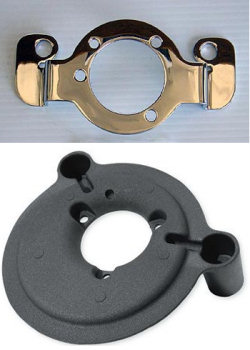 Air leaks are a common problem on carburetored bikes. Most often because not enough attention is paid to the alignment of the carb, bracket, manifold & heads when installing them. You MUST use a bracket of some sort, whether alone or part of the air cleaner backing plate, to mount the carb to the cylinder heads - the carb CAN NOT be supported by simply placing it on the manifold.
Air leaks are a common problem on carburetored bikes. Most often because not enough attention is paid to the alignment of the carb, bracket, manifold & heads when installing them. You MUST use a bracket of some sort, whether alone or part of the air cleaner backing plate, to mount the carb to the cylinder heads - the carb CAN NOT be supported by simply placing it on the manifold.
Install new manifold seals in the head intakes, especially if you have more than 5000 miles on the existing ones - they do wear out and leak. Loosely mount the manifold. Without installing the carb-to-manifold seal, carefully place the carb in the throat of the manifold. Now, put the carb mounting bracket in place - held there by the bolts into the heads (or the breather bolts).
The idea now is to temporarily mount the carb to the bracket to check the alignment with the manifold. While the manifold mounting bolts are still loose, you can move it slightly to get it into the right position. You can also slightly move the carb bracket to get the carb in the right position. You should see an even spacing around the carb where it sits in the manifold, thereby not stressing the seal when it is later put in place.
You also need to make sure the carb mounting bracket is properly mounted to the heads. Use sufficient washers behind the mounting plate (at the heads) to position the carb in the right location in the manifold. Now is the time to get all the spacing set correctly to reduce distortion on the seals and prevent air leaks.
Now, remove the carb & bracket - Tighten the manifold-to-heads bolts to keep the manifold in the position you selected - test fit the carb & bracket again - By test fitting the carb to the manifold before installing the seal for that junction, you can see exactly how it will fit in the mouth of the manifold and make a determination whether excessive stress will be placed on the seal.
The Carb-to-Manifold seal is THE MOST OFTEN ENCOUNTERED SOURCE OF INTAKE LEAKS - Due diligence now will pay off big in minimizing the chance for a seal leak later.
Once you have confidence in the alignment of the carb & manifold, put that seal in place on the manifold - LIGHTLY OIL THE INSIDE OF THAT SEAL - this will help the carb slip into place without binding or distorting the seal.
Insert the carb, attach the carb mounting bracket (which you are now confident will not distort the carb-to-manifold positioning), and bolt it all in place.
Simply Rebuilding / Refreshing The CV Carb
Disassembly
Cleaning & Inspecting
- Make sure to take everything apart, jets, needle, accel pump, all rubber components especially.
- Examine all parts for excessive wear, damage, distortion, etc.
- Cleaning solutions/sprays vary based upon your location, needs, budget, preferences and quality. Here are some ideas:
- An overnight soak in a solution of Pinesol and water followed up with a good brush down with a toothbrush then rinse and air dry. 16)
- A 20 minute soak in a gallon of Gunk (or other) Carburetor Cleaner that has a basket inside for small parts and lowers in the can with a handle, rinse, air dry, use.
- An aerosol spray carb cleaner will also work but may not loosen all of the build up in the jets or orifices in the carb body if they're not directly sprayed through.
- Blow out all holes, jets and orifices thoroughly with forced air after cleaning.
Replacement Parts
You can purchase individual parts or a rebuild kit. The kits will not have needles, jets or the spring, washer & o-ring for the Idle Mixture Screw.
The rebuild kits are usually less than $20 and include:
- Carb-to-Manifold Seal
- Carb-to-Air Cleaner Gasket
- Float Bowl Gasket/O-ring
- New Float Needle
- New Accelerator Pump Diaphragm & Spring
- Some Misc Parts/Seals
Assembly
- Do not lubricate the enrichment cable (misnamed Choke) on CV Carburetors - tension is needed. 17)
Add'l Info & Pics -
Accelerator Nozzle, Check Valve, Float Seat - http://xlforum.net/forums/showthread.php?t=1624208
Accelerator Nozzle & Check Valve - http://xlforum.net/forums/showthread.php?t=1775068
Accelerator Pump and Fuel Float Bowl
The Accelerator Pump (AP) is part of the Transfer function of the carburetor, providing additional fuel when the carb transitions from the Idle operation up to the acceleration and/or cruising operation.
The AP is attached to the Float Bowl. The AP has a diaphragm bladder that is operated by a rod connected to the throttle cam on the side of the carb. Because the Idle & Transfer ports are small, when the throttle is quickly opened, in order to keep the carb from starving for fuel, the AP sends fuel up thru a protruding tube (into the venturi) and sprays additional fuel into the carb air flow to keep a proper Air-Fuel-Ratio (AFR) during the transition.
There is a check valve utilized to keep the fuel from being pulled from the nozzle tube when the pump rod is released. When the rod is released, the pump sucks more fuel from the bowl and is ready for another transition event. In the 2003-earlier models, the check valve was in the nozzle tube. In the 2004-later models, it was moved to the AP body.
| Sportster Keihin CV40 Carb | |||
|---|---|---|---|
| Year | Float Bowl | Accl Pump Housing | Float Bowl Seal (O-ring) |
| 1988 | 27578-88 | No Accl Pump | 27577-88 |
| 1989-1990 | 27159-89 | 27160-89 | 27577-88 |
| 1991 | 27159-89A | 27160-89 | 27577-88 |
| 1992-2003 | 27159-92 | 27160-89 | 27577-92 |
| 2004-2006 - 883 | 27777-04 | 27260-00 | 27577-92 |
| 2004-2006 - 1200 | 27256-01 | 27260-00 | 27577-92 |
Enrichener Function (Choke)
The CV40 has an Enrichener Circuit - It is labeled Choke on the knob, but that is a misnomer, because a choke refers to a plate that restricts the incoming air supply. The enrichener circuit actually provides a path for additional fuel to bypass the carb controls and be injected directly into the air flow at the rear of the carb venturi.
Typically, the enrichener should only be utilized when starting the engine when it is completely cold. Put the enrichener on, let the bike idle for 1-3 minutes, then ride off. Turn the enrichener off as soon as the engine warms up (perhaps within 3-5 miles of riding)…
The Enrichener Knob is a friction function device. When mounting the knob, do not overtighten the mounting nut. The resistance/friction on the enrichener cable can be adjusted with the knurled nut.
- Loosen the hex nut & remove the cable from its mount.
- Put an adj wrench on the flat part of the cable mounting sleeve.
- Carefully turn the knurled nut to loosen or tighten the tension until the knob stays pulled out on its own yet freely can be pushed back in with reasonable pressure.
- Remount the cable & tighten the hex nut.
Check that the knob moves freely in and out after mounting. Do not overtighten the hex mounting nut.
The fuel for the enrichener circuit is drawn thru a fixed jet in the float bowl. The air for the enrichener circuit is taken in thru the banana shaped inlet at the top of the carb face (see the face pic above). Sometimes when the enrichener cable is moved, or the carb has been taken off the manifold, the valve piston does not properly seat into its cavity on the carb. If that happens, additional attention must be given to properly reseating the enrichener valve piston.
An XLForum Thread showing the replacement of the cable is here: http://xlforum.net/forums/showthread.php?t=848307
& gm1ll t=1553245

